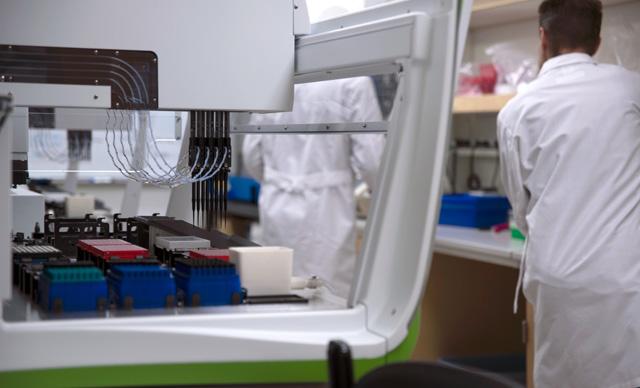
Q & A: Innovation in detecting COVID-19
Hands-on skills such as physical exams are being taught via Zoom to small groups.Please see related downloadable video resource
Q: How can new community sampling approaches contribute to faster, more effective public health responses in the event of respiratory virus outbreaks?
Widespread community sampling can support the public health system’s existing testing infrastructure by helping better detect, monitor, and control outbreaks earlier than with traditional testing methods alone.
In particular, the use of “swab-and-send” self-collection sampling can identify cases of infection that might otherwise go undetected, among those who have not yet sought medical care. Combining community sampling with traditional clinical testing can help public health officials cast a wide net into the general population and gain earlier, more complete understanding of fast-spreading respiratory viruses. This in turn allows them to better identify hot spots and more quickly and effectively implement containment and mitigation measures.
Q: Why is “swab-and-send” such an important innovation? What challenges in the current testing process does it help overcome?
Self-swab sample collection allows individuals who may be infected to be tested without leaving home. That can reduce the burden on the healthcare system, conserve personal protective equipment, and lower the chance of exposing others in the community to possible infection.
Self-swabbing is more comfortable for patients than clinical swabbing. It also allows public health officials to detect infection among those who are showing mild or no symptoms, or among those who have not yet sought medical care.
According to a New England Journal of Medicine paper published May 1, the Seattle Flu Study found that self-collected swab samples had a high accuracy rate in detecting COVID-19 in positive patients. The rate is consistent with clinician-collected samples. Interestingly, most of the people who had a case of the coronavirus confirmed through home testing did not seek medical care. Broad availability of self-swab sample collection kits can open a path to faster, more efficient, widespread testing. Greater availability of coronavirus testing is critical to the lifting of govement and public health stay-at-home orders.
Q: When will swab-and-send be more broadly available?
Studies are underway and showing great progress, including the approval of new swab types such as polyester and dry swabs. Researchers are optimistic that they will see approval for more widespread, at-home self-swab collection soon.
Q: How is the Seattle Flu Study contributing to the COVID-19 response?
The Seattle Flu Study has transitioned most of its resources to support public health response to the coronavirus outbreak in the Puget Sound area. On March 23, the team launched the greater Seattle Coronavirus Assessment Network (SCAN) under the direction of Public Health — Seattle & King County. SCAN’s goal is to better understand the spread of COVID-19 in the greater Seattle/King County region.
Three studies continue under the Seattle Flu Study banner: one to better understand transmission of respiratory disease in homeless shelters, another among healthcare workers in long-term care facilities, and a third to learn more about transmission of respiratory infection in households with young children.
Q: What’s next for the Seattle Flu Study/SCAN?
The Seattle Flu Study and SCAN are continuing to assist with local COVID-19 response by enrolling participants and learning more about the virus. They are continuing to refine and improve their methods and to share what they'relearning with public health officials and researchers across the country.
Written by the Seattle Flu Study team.
For details about UW Medicine, please visit https://uwmedicine.org/about.
